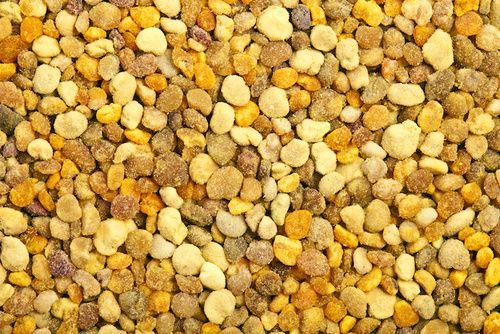Pollen it is a living food that acts on man in two major contexts: growth and organic balance. It has been used in natural medicine since time immemorial, especially as a nutritional supplement. Let's find out better.
> 1. What is pollen
> 2. Properties and benefits of pollen
> 3. Pollen, ally of

What is pollen
Pollen from flowers it is one of the richest substances that nature offers us. It is found all over the world but it is not an elaboration from the api such as honey, is simply collected from them on the flowers and constitutes the raw material for the production of royal jelly.
It is also widely used in a mixture with honey and royal jelly for food larvae and young bees (1 to 15 days of age).
THEcollection activities pollen by the bee is very complex. In practice, the pollen (yellowish powder, very fine and sticky made up of microscopic granules) remains trapped in the very thin hairs present on the body of the forager bee when it rests on the corolla of a flower to collect the nectar.
The bee, therefore, "cleans" away the pollen from the head and from the body by grouping and mixing the pollen with nectar, until the formation of almost spherical bullets transferred into special "baskets" (similar to small bags) located on the legs posterior (each pellet weighs an average of 7 mg). For this reason, pollen is also commonly known as "bee bread".
Returning to the hive, the pellets are placed inside a cell and repeatedly compressed and moistened with honey and saliva for the protein feeding of the larvae (each hive collects about 3 kg).
Properties and benefits of pollen
Pollen is one of the richest substances existing in nature. Considered by many to be the most perfect food on earth in terms of its full range of nutrients, it comes as a food rich in essential elements for the body and therefore to life because it brings what may temporarily be lacking.
Furthermore, being the raw material of royal jelly, it is not surprising that it is a food highly energetic (about 285 Kcal per 100g).
Each pollen grain is a biological unit that contains everything that is necessary for life:
- water in percentage ranging from 12 to 20%;
- a large amount of protein (on average 20%), most of them in the form of amino acids (21 of the 23 known amino acids), many of which fall into the category of essential amino acids;
- sugar in quantities of 15% (glucose and fructose);
- lipids (about 5%, variable content), most of which are essential fatty acids, 70% alpha-linoleic (omega 3), 3-4% linoleic (omega 6), 16-17% monounsaturated and saturated;
- mineral salts such as potassium, silicon, iron, magnesium, sulfur, chlorine, calcium, manganese, phosphorus, copper;
- a large number of Vitamins especially of group B (B1, B2, B3, B4, B5, B6, B7, B8, B9, B9, B12) vitamins A, C, D, E, K, PP;
- enzymes, coenzymes, growth hormones (estrogens, androgens, acetylcholine and other substances with antibiotic activity), pigments such as carotinoids, anthocyanins, etc.
Pollen has always been used as a tonic with innumerable properties. Here because
Pollen, ally of
Pollen is a live food which acts on man in two major contexts: growth and organic balance. It has been used in natural medicine since time immemorial, especially as a nutritional supplement since pollen contains almost all the substances necessary for the development and growth of an organism.
The most evident effect on humans, following regular administration, is theincreased appetite and metabolism in general. In particular it can be considered a general tonic especially in cases of excessive thinness and organic wasting.
In the literature there are several indications for pathologies of modest entity: constipation, constipation, colitis and intestinal infections, as well as having a toning and stimulating effect guaranteeing a sense of well-being and euphoria.
It has an effective anti-anemic action causing a rapid increase in the number of red blood cells and the rate of hemoglobin and therefore particularly useful for vegetarians who may experience a deficiency not so much of iron as of vitamin B12 (which is found almost exclusively in meat).
The two monosaccharide sugars (glucose and fructose) have a strong energetic and protective capacity of the heart and liver.
How to consume pollen
On the market it comes in the form of balls with a grainy shell, rigid and impermeable, with a sweet and aromatic scent, very similar to that of flowers, a soft and malleable consistency and a color that varies according to the origin of the plant species from which it was harvested.
The consumption of the pollen balls takes place chewing slowly and accurately. To avoid gastric acidity (not all organisms accept pollen willingly) it is advisable to chew it for a long time or dilute it possibly with the help of a lukewarm drink (water, milk or herbal tea). This also obviates the taste of the pollen which is not particularly inviting!
The pollen can also be consumed mixed with honey, jam or with some yogurt.
The recommended amount is about 15/20 g per day for an adult (a level tablespoon) and 5/10 g for a child for a duration of 1-3 months. The best time to consume it is in the morning on an empty stomach, before breakfast.
It is recommended in convalescence, to anemics (also due to the high copper content), to children, to the elderly, to the inappetent, to pregnant and breastfeeding women and to physical and mental overmenage.
READ MORE
Pollen among the supplements against fatigue: discover the others!
Other articles on pollen:
> Discover the properties of the other products of the hive


























